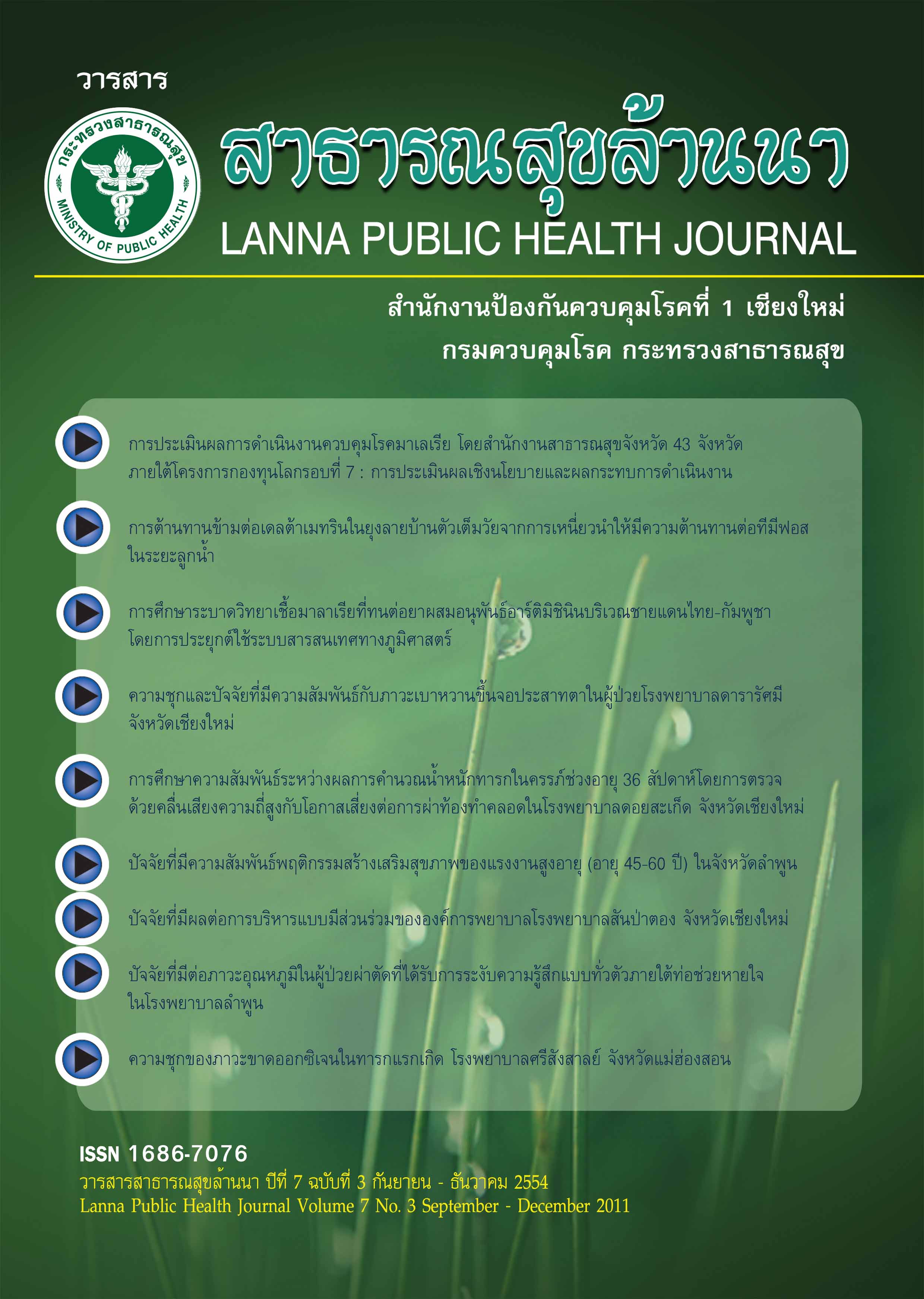การต้านทานข้ามต่อเดลต้าเมทรินในยุงลายบ้านตัวเต็มวัยจากการเหนี่ยวนำให้มีความต้านทานต่อทีมีฟอส ในระยะลูกน้ำ
คำสำคัญ:
ยุงลายบ้าน, ทีมีฟอส, เฟอร์เมทริน, เดลต้าเมทริน, ความต้านทานข้ามบทคัดย่อ
ความต้านทานข้ามต่อสารฆ่าแมลงเป็นปัญหาหนึ่งที่สำคัญในการควบคุมแมลงพาหะด้วยการใช้สารเคมี ยุงลายบ้าน (Aedes aegypti) เป็นแมลงพาหะสำคัญในการนำโรคไข้เลือดออก ปัจจุบันมีรายงานการเกิดความต้านทานต่อสารฆ่าแมลงหลายชนิดในยุงลายบ้านอย่างแพร่หลาย วัตถุประสงค์ของการศึกษาครั้งนี้จึงทำการศึกษาการต้านทานข้ามต่อสารเคมีไพรีทรอยด์สังเคราะห์ในยุงลายบ้านตัวเต็มวัย จากการเหนี่ยวนำลูกน้ำให้มีความต้านทานต่อทีมีฟอสด้วยวิธีทางห้องปฏิบัติการ โดยการคัดเลือกเลี้ยงลูกน้ำจำนวน 6 รุ่น ที่รอดชีวิตจากการสัมผัสกับทีมีฟอสความเข้มข้น 0.0156 มิลลิกรัมต่อลิตร ให้เจริญเติบโตเป็นยุงตัวเต็มวัย จากนั้นทำการประเมินความไวต่อสารฆ่าแมลงของยุงตัวเต็มวัยแต่ละรุ่น โดยใช้กระดาษชุบสารเคมีเดลต้าเมทริน 0.05% และเพอร์เมทริน 0.75% จากการศึกษาพบว่า ลูกน้ำยุงลายบ้านมีการพัฒนาความต้านทานต่อทีมีฟอสเพิ่มมากขึ้นอย่างมีนัยสำคัญทางสถิติในยุงรุ่นที่ 1-6 และพบการเพิ่มขึ้นของความต้านทานต่อเดลต้าเมทรินทั้งในอัตราการน๊อก-ดาวน์ และอัตราการตายของยุงตัวเต็มวัย ในขณะที่ความต้านทานต่อเพอร์เมทรินนั้นอยู่ในระดับสูงและคงที่ในยุงทั้ง 6 รุ่น จากค่าสัมประสิทธิ์สหสัมพันธ์เพียร์สันแสดงให้เห็นว่าการเพิ่มขึ้นของความต้านทานต่อทีมีฟอสของยุงในระยะลูกน้ำมีความสัมพันธ์เชิงบวกกับการเพิ่มขึ้นของความต้านทานต่อเดลต้าเมทรินของยุงตัวเต็มวัย ทั้งในอัตราการน๊อก-ดาวน์ (r=0.812) และอัตราการตาย (r=0.798) ซึ่งสามารถสรุปได้ว่าความต้านทานต่อเดลต้าเมทรินในยุงลายบ้านตัวเต็มวัยนั้น สามารถพัฒนามาจากความต้านทานต่อทีมีฟอสในยุงระยะลูกน้ำ ดังนั้นจึงควรตระหนักอย่างมากในการใช้ทีมีฟอสในการควบคุมกำจัดลูกน้ำยุงลายบ้านอย่างถูกต้อง เพื่อเป็นการป้องกันปัญหาการเพิ่มขึ้นของความต้านทานและการเกิดความต้านทานข้ามต่อไป
เอกสารอ้างอิง
levels. Pak J Biol Sci 2007; 10 (20): 3688-92.
Brengues C, Hawkes NJ, Chandre F, et al. Pyrethroid and DDT cross-resistance in Aedes aegypti is correlated with novel mitations in the voltage-gated sodium channel gene. Med Vet Entomol 2003; 17(1): 87-94.
Brogdon WG, McAllister JC. Insecticide resistance and vector control. Emerg Infect Dis 1998; 4(4): 605-13.
Chareonviritaphap T, Aum-aung B, Ratanatham S. Current insecticide resistance patterns in nosquito vectors in Thailand. Southeast Asian J Trop Med Public Health 1999; 30(1): 184-94.
Che-Mendoza A, Penilla RP, Rodriguez DA. Insecticide resistance and glutathione S-transferases in mosquitoes: a review. African J Biotech 2009; 8(8): 1386-97.
Jirakanjanakit N, Rongnoparut R, Saengtharatip S, Chareonviritaphap T, Duchon S, Bellec C, Yoksan S. Insecticide susceptible/resistance status in Aedes (Stegomyia) aegypti and Aedes albopictus (Diptera: Culicidae) in Thailand during 2003-2005. J Econ Entimol 2007b; 100(2): 545-50.
Jirakanjanakit N, Saengtharatip S, Rongnoparut R, Duchon S, Bellec C, Yoksan S. Trend of temephos resistance in Aedes (Stegomyia) mosquito in Thailand during 2003-2005. Environ Entomol 2007a; 36(3): 506-11.
Jurjevskis I, Stiles AR. Summary review of larvicides (for mosquitoes) tested at stage IV/V field trials 1964-1977. Document WHO/VBC/78.668. Geneva: World Health Organization, 1978.
Macoris ML, Andrighetti MT, Takaku L, Glasser CM, Garbeloto VC, Bracco JE. Resistance of Aedes aegypti from the state of Sao Paulo, Brazil, to organophosphate insecticides.Mem Inst Oswaldo Cruz 2003; 98(5) 703-8.
Mazzarri MB, Georghiou GP. Characterization of resistance to organophosphate, carbamate, and pyrethroid insecticides in field population of Aedes aegypti from Venezuela. J Am Mosq Control Assoc 1995; 11(3): 315-22.
Montella IR, Martins AJ, Viana-Medeiros PF, Lima JB, Braga IA, Valle D. Insecticide resistance mechanisms of Brazilian Aedes aegypti populations from 2001 to 2004. Am J Trop Med Hyg 2007; 77(3): 467-77.
Nimmannitya S. Dengue heamorrhagic fever in Thailand. Southeast Asian J Trop Med Public Health 1987; 18(3): 291-4.
Paeporn P, Komalamisra N, Deesin V, Rpngsriyam Y, Eshita Y, Thongrungkiat S. Temephos resistance in two forms of Aedes aegypti and its significance for the resistance
mechanism. Southeast Asian J Trop Med Public Health 2003; 34(4): 786-92.
Paeporn P, Supaphathom K, Sathantriphop S, Mukkhun P, Sangkitporn S. Insecticide susceptibility of Aedes aegypti in Tsunami-affected Areas in Thailand. Dengue Bull
2005; 29: 210-3.
Ponawat A, Scott JG, Harrington LC. Insecticide susceptibility of Aedes aegypti and Aedes albopictus across Thailand. J Med Entomol 2005; 42(5): 821-5.
Prapanthadara L, Promtet N, Koottathep S, Somboon P, Suwonkerd W, Mccarroll L, Hemingway J. Mechanisms of DDT and permethrin resistance in Aedes aegypti trom
Chiang Mai, Thailand. Dengue Bull 2002; 26: 185-9.
Rattanarithikul R, Panthusiri P. Illustrated keys to the medical important mosquitoes of Thailand. Southeast Asian J Trop Med Public Health 1994; 25 (suppl 1): 1-66.
Rodriguez MM, Bisset JA, Fernandez D. Levels of insecticide resistance and resistance mechanisms in Aedes aegypti from some Latin American countries. J Am Mosq
Control Assoc 2007; 23: 420-9.
Rodriguez MM, Bisset JA, Ruiz M, Soca A. Cross- resistance to pyrethroid and organophosphorus insecticides induced by selection with temephos in Aedes aegypti
(Diptera: Culicidae) from Cuba. J Med Entomol 2002; 39(6): 882-8.
Rozendaal JA. Vector control. Methods for use by individuals and communities. Geneva: World Health Organization, 1997: 132-3
.
Rutledge LC, Ward RA, Gould DJ. Studies on the feeding response of mosquitoes to nutritive solutions in a new membrane feeder. Mosq News 1964; 24: 407-19.
R. Bottle and biochemical assays on temephos resistance in Aedes aegypti in Thailand. Southeast Asian J Trop Med Public Health 2005; 36(2): 417-25.
Somboon P, Prapanthadara LA, Suonkerd W. Insecticide susceptibility tests of Anopheles minimus s.1., Aedes aegypti, Aedes albopictus, and Culex quinquefasciatus in
northern Thailand. Southeast Asian J Trop Med Public Health 2003; 34(1): 87-93.
Sornpeng W, Pimsamarn S, Akksilp S. Resistance to temephos of Aedes aegypti Linnaeus larvae (Diptera: Culicidae). J Health Sci 2009; 18(5): 650-4.
Thanispong K, Sathantriphop S, Chareonviriyaphap T. Insecticide resistance of Aedes aegypti and Culex quinquefasciatus in Thailand. J Pesticide Sci 2008; 33(4): 351-6.
Wirth MC, Grorghiou Gp. Selection and characterization of temephos resistance in a population of Aedes aegypti from Tortola, British Virgin Islands. J Am Mosq Control
Assoc 1999; 15(3): 315-20.
World Health Organization. (1998). Test procedures for insecticide resistance monitoring in malaria vectors, bio-efficacy and persistence of insecticide on treated surfaces. Report of the WHO Informal Consultation, 28-30 September 1998, WHO/HQ, Document WHO/CDS/CPC/MAL/98.12 Geneva: World Health Organization, 1998.
Yaichaoen R, Kiatfuengfoo R, Chareonviriyaphap T, Rongnoparut P. Characterization of deltamethrin resistance in field popupations of Aedes aegypti in Thailand. J Vector
Ecol 2005; 30(1): 144-50.








